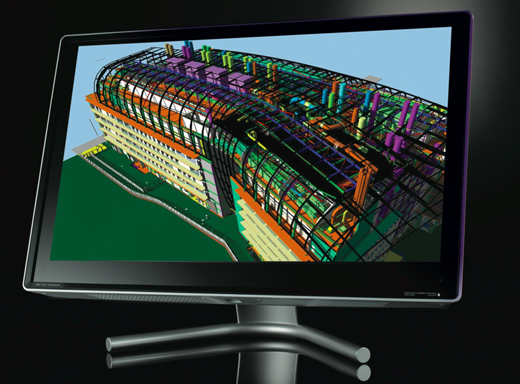Take up of building information modelling (BIM) in North America has now reached 71%, study finds.
Proponents say that BIM allows you to build a building twice – first, digitally, where mistakes don’t cost, and only then in real life when the design is perfected.
This, so the argument goes, eliminates costly redesigns, detects clashes before work begins and provides all service providers with the information they need up front.
Which is why BIM fans and software vendors will have cheered at the news that in North America, according to a recent study, the take up of BIM now stands at 71%, marking a rapid expansion from 28% in 2007.
BIM uses software to create a rich 3D model of a building prior to construction. Unlike CAD, the model contains detailed information about all the building’s elements – down to the bathroom taps, if necessary.
It’s considered so beneficial in the UK, where adoption is only at 31%, that the central government wants all its projects to be executed with it by 2016.
In South Korea, where BIM is still relatively new, adoption has reached 58%, according to McGraw Hill Construction, which conducted the North American study.

Contractors’ adoption rate is 74%, trumping architects’ 70% (Credit: McGraw-Hill Construction)
It found that contractors are embracing BIM more than all other types of firms, including architects, who were early adopters in the US.
At the end of the study period, 2012, contractors’ adoption rate stood at 74%, trumping architects’ rate of 70%. Considering the risk contractors bear when designs are faulty or incomplete, that makes sense.
Engineers, who “still struggle with issues of content and technical analysis”, according to the report, have a 67% adoption rate, with mechanical and electrical engineers leading the charge.
The study found that building owners are still relatively light users, but Patrick MacLeamy, CEO of architecture firm HOK and chairman of BIM advocacy group, buildingSMART International, said: “Over the next 10 years, building owners will demand ever-increasing usage of BIM as a precondition, ushering in a new era of accuracy, quality and sophistication for the building industry.”
Given the tough economic times, the report’s authors were surprised at the Americas BIM surge. After all, using it requires considerable investment in software licensing, training and generally doing things differently.
“Though it may seem counterintuitive to increase spending during a recession,” said Stephen Jones, senior director at McGraw-Hill Construction, “the research indicates that the industry is continuing to invest in a more efficient and productive future by embracing technologies and processes of BIM.”
To crunch the numbers more finely, McGraw-Hill invented a “BIM Engagement Index” based on each user’s skill level, years of BIM experience, and percentage of their projects using BIM.
The study found that, like many things in life, the more you put in with BIM, the more you get out:
- 13% of BIM users demonstrate a very high BIM engagement level (e-level), requiring expert skill level, five or more years of experience, and implementation of BIM on more than 60% of their projects;
- 67% of the very high e-level users report a very positive return on investment (ROI) – 25% or higher – versus only 20% of low e-level BIM users, two-thirds of whom are at negative or break-even ROI;
- 52% of very high e-level users experience increased profits from their use of BIM compared to the 36% average for all users.
The report, “The Business Value of BIM in North America: Multi-Year Trend Analysis and User Ratings (2007-2012)” can be downloaded here.










